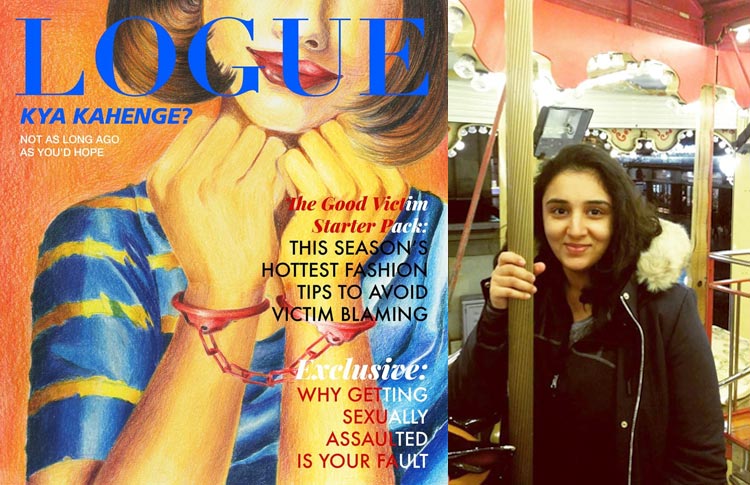
Shreya Arora- The True Wonder Woman
The biased and compromised gender roles in our real world prick at our minds every day. But, what about the world of fantasies and superhumans? The gender roles are probably not dysfunctional like they are in the real world because how can they be, right? After all, the good always prevails over the evil in the fantasy world! The superheroes, both male and female in the world of fantasy comics, all enjoy equal super strength and powers. Then how can there be even the slightest hint of problematic gender roles?
Well, much to the disappointment of the real world, problematic and dysfunctional gender roles are very much the underlying and understated issue in the world of superhuman comics shadowed under the deceiving extravaganza of the superhuman powers endowed on the female superheroes.
Shreya Arora is a graphic designer of 21, who has set out to redeem the real world from the deceit of the world of fantasy through her artwork. Her most recent venture, ‘Sexism in Comic Book Art’, paints the real picture of the blatant sexism that remains hidden in the otherwise close to perfect world of comics.
An Endeavor To Swap Sexism Out
Imagine swapping the dressing sense of Superman and Wonder Woman. Wonder Woman completely clothed in the blue sort of jumpsuit, a cape and, yes, of course, the red underwear (which for some bizarre reason, I am sure, is necessary). Now try viewing Superman half-naked in the armour of Wonder Woman, posing for a cover in a fashion that draws attention to his butt and chest, with a mild but confident smile –just as Wonder Woman is seen in so many comic book covers.

The absurdity of even the imagination of this swapped dressing makes one uncomfortable, doesn’t it? This is probably what Shreya Arora aims at doing – pointing the bizarre objectification of female superheroes and exposing it in the broad daylight. The sexist images of the covers of the comic books have drawn her attention into exposing it, by turning the whole narrative of the covers upside down. In trying to do so, she has depicted the male superheroes, in her version of the covers, as posing in the manner and dresses female superheroes are usually shown posing in.
Talking about the sexism embedded in the comic book narratives, Shreya has to say, “Choosing comic books to talk about sexism in the real world may seem unconventional, but one cannot deny that real sexism is shown through these fictional characters.”

Shreya’s artwork aims at initiating a much necessary conversation and at encouraging minds into raising questions as to why there is a big leap of difference in the depiction of superheroes and superheroines.
Recalling the moment of truth in her life, Shreya reveals, “One option was to take covers with strong, iconic depictions of superheroes, and recreate them with women. However, I realized that while it would be a positive take, it wouldn’t have the shock value that is necessary to make people question the status quo. Hence, I decided on a drastic take and recreate sexist covers of superheroines with superheroes to highlight how bizarre it looks.”
Curbing The Casual Sexism To The Side
It is clearly simple to put into saying, that the female characters in the comic books are treated like trivial characters just in the passing –often restrained to a minor love interest or maybe a subplot operating under a greater design of events. They are destined to be either rescued or sacrificed, simply for the sake of uplifting the mighty masculinity of the superheroes.
However, there’s a third option for the female character’s fate –fill her up with some good amount of strength and supernatural powers, put her into skimpy clothes and place her on the cover of the comic books. The only two options for a female character’s fate in a comic book. Not surprisingly, the makers of comic books have gone for a defence of their stand and called such an atrocity a “business decision”, commenting that “the readers don’t care about them” –the “them” implying female characters.

With such casually sexist justification, Shreya disagrees, especially when she says, “The fact that it’s a business decision doesn’t make it any less wrong. Comic books are absolutely created keeping a section of the audience in mind, which leads to a vicious cycle. Companies create problematic content for a specific demographic, and then use that demographic as an excuse to keep creating problematic content.”
In fact, according to Shreya, comic books follow a standard that has been set by an unfortunate world driven by testosterone that is unapologetically biased towards men.
Keeping The Chin Up In The Face Of Criticism
Even though, the fantasy world of comic books is nothing but fictional, it must be acknowledged that the female characters in these books are restricted within the circle of being nothing but accessories to the story of the privileged masculinity of the superhero.
Drawing an intimate line between the sexist fantasy world and its mirrored sexist real world, Shreya questions, “Would the Joker ever rape Robin to anger Batman, close as Batman and Robin may be? All these ideas being propagated once again contribute to the objectification of women, and reduce them to nothing beyond a vagina.”

The outspoken Shreya collaborated with BuzzFeed India in the creation of a section of the series of superhero narrative. However, her intentions fell under the knife of fierce criticism, especially from the Facebook community who categorically demanded her to “leave the comic books alone.”
Such rampant criticism is perhaps the biggest sign of how sexism has casually been normalized and ensconced within the very foundations of our society.
Despite the strong criticism, Shreya maintained her position when she said, “Appreciating an art form doesn’t mean giving it a free pass to be as problematic as it’d like. As fans, it’s up to us to call the industry out on these practices.”
Sexism And Victim-Blaming In The Context Of Indian Comics
Focusing more on the front of popular Indian comics like Chacha Chaudhary and Tinkle, Shreya realizes that even though hyper-sexualizing women characters isn’t a problem in this case, yet “sexism permeates our cultures in many ways.” Women’s identities in the Indian comic books are stereotypically restricted within their relationships with men, be it nagging wives, rebellious daughters or even possessive girlfriends.

In fact, while attending her French exchange program, she claims to have clarified various westernized stereotypical ideas about India, until it dawned n her that “a lot of it was true” –especially regarding the rate of cases on sexual assault and the manner in which the media presented them.
Shreya talks about a recent poster series she created on this particular issue of the problems of victim blaming in India when she says, “I realized how much victim-blaming affects our narratives, and how our standards for ‘good’ women are incredibly high, while we rarely ever bother to hold the perpetrators to the same high standards. The series is a satire on this fact, and shows you that no matter how good, conservative, or perfect a victim is, society will find a way to blame her for the assault.”
On Works Now And Later
The latest works of Shreya haven’t received their due attention yet to start a mass conversation overnight. However, she warns that there’s a bar of privilege that comes as a part and parcel with her artwork in order to initiate a conversation –it is comprehensible only to a certain section of the society that includes people with fluency in English and with visual literacy.

A little sceptical, Shreya claims, “With so many young, passionate artists who are working on social issues, there is no lack of good intent. However, we may not always be equipped to bring about a change at a grass root level.”
Nevertheless, a wishful artist as she is, Shreya plans on working on “issues that emanate from privilege”, in the future.

So, it is really a question of how often do we dare to really look into the problems within our own surroundings and acknowledge them as Shreya Arora has done.
“What I’ve learned from this project, though, is there will always be a bigger problem to solve, but that shouldn’t stop you from working on the smaller ones you are more equipped to face. I absolutely understand that sexism in comic books is a much smaller problem (one that affects the relatively privileged) for the field of women empowerment than, say, female illiteracy, but I’ve learnt that tomorrow if I work on female illiteracy, there’ll always be someone who’ll say that the war in Syria is a bigger problem.”














